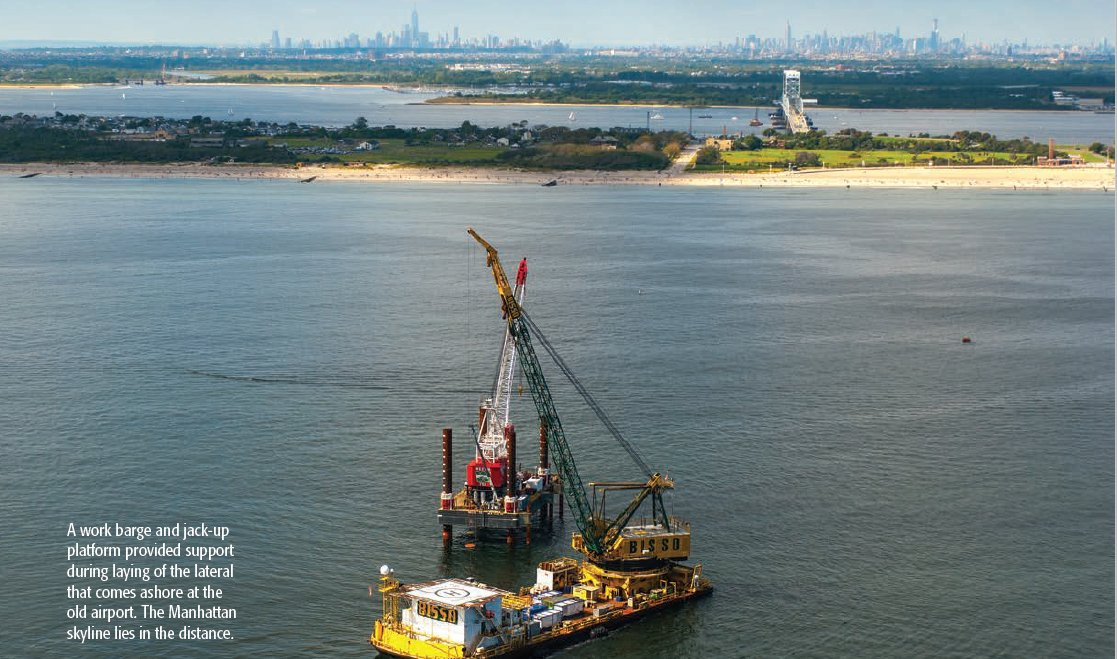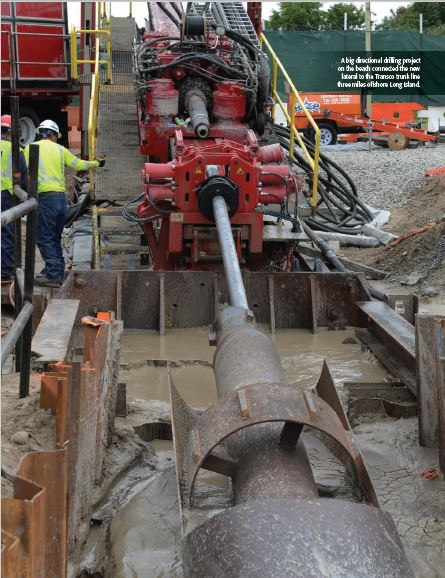
Where do you place a one-acre, industrial natural gas metering and regulating (M&R) station in one of the most densely populated cities in the world?
That is the question pipeline engineers with The Williams Cos. Inc. wrestled with seven years ago as they planned a new natural gas pipeline delivery point to serve New York City utility National Grid. The solution stands as a case study in innovative collaboration between private business and a federal agency to address energy infrastructure needs, while restoring a historic piece of the city’s past.
Williams’ Rockaway Delivery Lateral project was designed to provide about 647,000 dekatherms per day of natural gas to National Grid’s gas distribution system in Brooklyn, providing both supply flexibility and the ability to meet current and future incremental demand growth. The project design included the installation of 3.2 miles of 26-inch offshore pipeline and a state-of-the-art, 60,000-square foot metering and regulating station.
New York challenge
In any other location in the world, a project of this scope would be relatively standard to execute. But siting facilities in New York City created extraordinary challenges that required innovative solutions.
Attempting to avoid the aesthetic impacts normally associated with the design and siting of metering facilities, Williams coordinated with the U.S. National Park Service to develop a plan to place the meter station on historic Floyd Bennett Field, inside one of the closed airport’s abandoned airplane hangar buildings. Although historically significant, the hangar buildings were in serious disrepair and in danger of collapse.
Once an important New York City airport, Floyd Bennett Field is today part of Gateway National Recreation Area. The old airport was a point of departure for record-breaking flights of famous aviators including Amelia Earhart and Howard Hughes. The site opened in 1931 as New York’s first municipal airport and was converted to a Naval Air Station in 1941. It was then the most active airport in the U.S. during World War II.
For years, the National Park Service had desired to address the deteriorating hangars but limited funds had prevented the agency from pursuing any long-range refurbishment plans. That was until Williams approached the service with an outside-the-box idea.
Project complexities
The Rockaway project was unique in its complexity, not only because of its location in New York City, but because it involved offshore and onshore pipeline segments that required coordination between numerous local, state and federal permitting agencies. One key component of the project even required an actual act of Congress to move forward—a trigger needed to allow for the operation of natural gas facilities on National Park Service property and a hurdle many believed would be impossible to obtain.
Ultimately, the project’s unique design and location helped it avoid residential, commercial and sensitive environmental areas. Most of the pipeline lateral was constructed offshore with the shoreline crossing utilizing subsurface directional drilling technology, allowing Williams to avoid all impacts to the beach, near-shore areas, as well as onshore portions of nearby Jacob Riis Park.
Construction on the massive project began in the summer of 2014 and was ultimately placed into service in the first half of 2015. Although the project features just a little more than three miles of pipe, the complexities of this extraordinary project actually took more than six years to plan and permit.
The offshore installation included two subsea hot taps of an existing 26-inch pipeline, a subsea manifold designed to house a portable, pre-loaded subsea pig launcher and about three miles of buried pipeline. The offshore team was also responsible for welding, testing and supporting pipe for pullback of the shore approach horizontal directional drill.
There were many challenges facing the offshore team throughout construction. Strict regulatory requirements called for deeper burial depths with immediate backfill, but the rapid and strong currents displaced bottom material very quickly. Heavy recreational use of the area due to its proximity to shore required that picket boats patrol the area at all times to protect the work zone and the public.
For the onshore team, the biggest challenge was where to site the 60,000-square-foot meter and regulator station, necessary to measure, condition and control the flow of natural gas before it enters the local natural gas distribution system.
A plan was developed to site the facilities inside one of the historic airplane hangars. Unfortunately, because this property is operated by the U.S. National Park Service, the U.S. Congress would first have to pass a law allowing for the construction of the metering and regulating facility on park property.
“Most people thought getting an act of Congress was going to be impossible,” said Stephen Kellogg, project manager. “But this location offered tremendous benefits to the customer, while minimizing impacts to people and the environment. That’s why we felt like we had to give it a try.”
He added, “It certainly wasn’t easy or quick, but fortunately we were able to get it done.”
Restoration process
With the act of Congress in place, the next challenge was to lawfully design the rehabilitation of the airplane hangar to adapt it for use as a meter and regulator station. Because it is listed on the U.S. National Register of Historic Places, the rehabilitation had to meet the strict standards established by the U.S. Secretary of Interior. These standards are upheld by the National Park Service staff, which assumed the role of client for the rehabilitation project.
According to Kellogg, it took nearly four years to survey and study the building and design the rehabilitation—all the time working with National Park Service staff to ensure that it met the Secretary’s standards. The project also had to be approved by the New York State Historic Preservation Office (SHPO), which was significant due to the magnitude of the rehabilitation project.
“This wasn’t a simple offset mitigation that you might find in a traditional pipeline project,” Kellogg said.
The process of obtaining a “no adverse effect” ruling from SHPO began with the development of a Historic Structure Report (HSR). This effort alone turned out to be about 600 pages in the final submittal and included hundreds of photos, drawings, and it took thousands of hours to prepare. The HSR’s purpose was to identify the character-defining features of the building and develop a plan for rehabilitation, preservation or reconstruction. Because the facilities were in disrepair, a substantial amount of cleanup and stabilization had to be performed in order to conduct surveys and allow for access.
Innovative engineering
With the plan for the structure complete, the next challenge was to engineer the M&R station design.
“M&R facilities are typically built in the open air, not in buildings,” Kellogg said. “They are rarely, if ever, placed in historic structures. For these reasons, our natural gas codes, building codes, fire and electrical codes all needed to be reconciled to find the common ground within which we could design the station and the building rehabilitation.”
The adaptive reuse was part of the “no adverse effect” determination from SHPO. Unique design solutions were utilized given the unusual constraints of placing the M&R facility in a nationally registered historic structure. For example, to minimize excavation the team incorporated overhead headers and cable tray into the design. A typical open-air M&R station would have conventional water bath heaters. Due to area classifications and enclosed spaces, heaters and heat exchangers with intricate control loops and operating philosophy had to be used. And because all of this equipment is located indoors, mechanical ventilation was utilized to ensure air quality throughout the facility.
Operating in a national park with many visitors throughout the year, the team recognized the importance of being good neighbors, which meant keeping odor and noise to a minimum. That meant routing bleed-off gas to the customer’s low-pressure system, reducing the amount of vented odorized gas, shrouding the regulators in noise-attenuating curtains and housing the back-up generators in a noise-reducing enclosure.
Station construction
Under such unique circumstances, station constructability was a major consideration and something the Williams team began planning in 2010.

A building protection plan was developed and implemented. This included seismic monitoring, which measures vibration from ongoing construction activities inside the building. Also, because of its proximity to the shore, everything had to be supported by piles. Over 200 piles were installed, driven inside a building with no more than 22 feet of head room.
Another innovative construction technique applied was the utilization of precast concrete trenches. These trenches helped minimize excavation in a very tight area and allowed for Williams to build “bridges” to efficiently move equipment around. Additionally, the entire facility was pre-fabricated and tested offsite, utilizing flanged connections, disassembled and moved into the hangars. This method minimized the amount of equipment needed on site as well as the weld time on site with open trenches.
“Through a dedicated team effort, we are thrilled to say that the station is now all constructed and operational, the hangars are fully rehabilitated with full functioning sliding hangar doors, and all contractors are off site,” Kellogg added.
Win-win-win
By partnering with Williams, the Park Service was finally able to see the hangars’ exterior rehabilitated to their historically accurate original condition. At the same time, the agreement generates lease payments paid by Williams to the service that can be used to address other critical needs, including natural resource protection and enhanced visitor services.

“We saw this solution as a win-win-win,” said Frank Ferazzi, vice president and general manager of Williams’ Transco pipeline unit. “The park and its visitors benefit by seeing historic structures restored, while sensitive environmental areas are protected. The city residents benefit from the additional gas supply that will allow homeowners and apartment buildings to switch from more expensive fuels. And the region as a whole benefits from cleaner air and greater opportunities for economic growth.
“It is a great example of the kind of creativity and innovative thinking we have to apply in today’s environment in order to overcome the challenges we face in installing new pipeline

Recommended Reading
US Drillers Add Oil, Gas Rigs for Second Week in a Row, Baker Hughes Says
2025-02-07 - Despite this week's rig increase, Baker Hughes said the total count 6% below this time last year.
PotlatchDeltic Enters Lithium, Bromine Lease Agreement in Arkansas
2025-02-06 - PotlatchDeltic’s agreement with gives Tetra Brine Leaseco covers about 900 surface acres in Lafayette County, PotlatchDeltic says.
McDermott Completes Project Offshore East Malaysia Ahead of Schedule
2025-02-05 - McDermott International replaced a gas lift riser and installed new equipment in water depth of 1,400 m for Thailand national oil company PTTEP.
SLB: OneSubsea to Provide Equipment for Vår Energi Offshore Norway
2025-02-04 - The OneSubsea joint venture among SLB, Aker Solutions and Subsea7 will support multiple oil and gas projects on the Norwegian Continental Shelf for Vår Energi.
Resurrected Enron Hijinks Gets Serious with New Electric Business
2025-02-03 - After Enron returned as a seemingly elaborate hoax, Enron Energy Texas’ vice president told Hart Energy the company aims to deliver real electricity to consumers.
Comments
Add new comment
This conversation is moderated according to Hart Energy community rules. Please read the rules before joining the discussion. If you’re experiencing any technical problems, please contact our customer care team.




